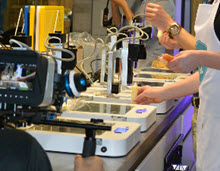3D printing technology for value-added red meat
23 March 2017

Three-dimensional (3D) food printing will be the focus of a major conference to be held in Melbourne on 2 May, particularly the opportunities this technology has for the red meat sector.
The 3D Food Printing Conference Asia-Pacific, supported by Meat & Livestock Australia (MLA) and organised by Jakajima, will bring expert speakers in the 3D printing field together to discuss the future potential of this technology in food delivery at Monash University, Food Innovation Centre.
The Asia-Pacific conference follows a similar successful event organised by Jakajima in Europe in 2016, which heard about the existing uses of 3D technology, as well as potential future opportunities.
As with every 3D printing application, there is a lot of hype around 3D food printing. Not only are large companies utilising the technology, but many start-ups are introducing 3D food printers as part of their set-ups. Last year’s conference in Europe heard about how people can already now eat 3D printed dinners in restaurants.
For red meat, 3D printing represents an exciting opportunity to add value to current secondary cuts, trims and by-products by developing “meat ink”. For example, in the aged care sector, 3D printing provides an opportunity for the red meat industry to offer high protein and nutritious meals that can be presented in various shapes and sizes, and more appetising than the traditional pureed food.
There is a need to create new business models to meet the demands of the different markets who want personalised approaches to nutrients or textures, rather than the current whole muscle product.
MLA General Manager – Research Development & Innovation, Sean Starling, said the conference is an opportunity to hear from global speakers and see demonstrations of 3DP food technology – and follows a recent research project by MLA which reviewed market acceptance and the value proposition for 3D printed food with meat as an ingredient.
"For the Australian red meat industry to remain globally competitive we have to embrace innovation and new technology to ensure we continue to grow our markets and provide greater value for the industry,” Mr Starling said.
“Learning more about 3D technology and engaging with industry as to what's next will be a key outcome of the conference."
The 3D Food Printing Conference will tackle all aspects of the new market opportunities and challenges from this technology.
Speakers from Forbes Meisner, byFlow, University of Canberra, University of Wollongong and many more will tackle topics related to 3D Printing Technology for Value-Added Red Meat.
For further information about the 3D Food Printing Conference Asia-Pacific, visit: https://3dfoodprintingconference.asia/


